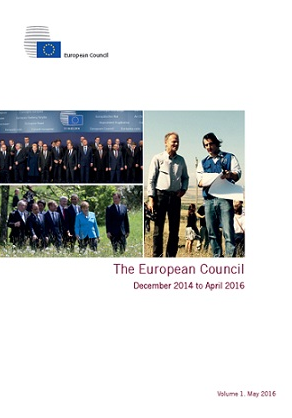Alistair Milne, Paul Parboteeah, (2016), “The Business Models and Economics of Peer-to-Peer Lending”, ECRI Researcb Report No. 17, Μάϊος This paper reviews peer-to-peer (P2P) lending, its development in the UK and other countries, and assesses the business and economic policy issues surrounding this new form of intermediation. P2P platform technology allows direct matching of borrowers’ and lenders’ diversification over a large number of borrowers without the loans having to be …Read More
The Euro Plus Monitor Spring 2016 Update
Holger Schmieding, (2016), “The Euro Plus Monitor Spring 2016 Update”, The Lisbon Council, 22 Μαϊου Europe can adjust. It has done so before. In the 1980s, Margaret Tatcher cured the “sick man of Europe.” In the 1990s, Scandinavian countries reformed their bloated welfare states. From 2004 to 2006, Germany turned its struggling economy into a new growth engine for Europe through serious labour market and welfare reforms. And, in many …Read More
Recent trends in euro area banks’ business models and implications for banking sector stability
Christoffer Kok, Csaba Móré, Monica Petrescu, (2016), “Recent trends in euro area banks’ business models and implications for banking sector stability”, ECB Financial Stability Review, Μάϊος This special feature reviews recent trends in business model characteristics, discusses their relationship with bank stability and performance, and looks at how this relationship has changed over time, comparing the period before the crisis with the crisis years and the current situation.The financial crisis and …Read More
Fiscal Consolidation in Ireland: Recent Successes and Remaining Challenges
Larch, Martin ,Malzubris, Janis, Santacroce,Stefano,(2016),”Fiscal Consolidation in Ireland: Recent Successes and Remaining Challenges”, Directorate-General for Economic and Financial Affairs/ European Economy Economic Brief 011, Μαϊος Ireland very successfully shouldered an impressive amount of fiscal consolidation under its 2011-2013 EU-IMF financial assistance programme. After peaking at around 12% of GDP in 2009 (excluding deficit-increasing financial sector measures), the general government deficit is expected to have fallen below 2% of GDP in 2015. …Read More
The European Council: December 2014 to April 2016
European Council, (2016), “The European Council: December 2014 to April 2016”, European Council, Volume 1. May 2016 The European Council faced critical political challenges from December 2014 to April 2016. These included unprecedented flows of asylum seekers and irregular migrants, the need to prevent the exit of Greece from the eurozone and the imperative to find a new settlement for Britain ahead of an In/Out referendum on EU membership. European leaders …Read More
Fiscal Reaction Functions for European Union Countries
Berti, Katia, Colesnic, Eugeniu, Desponts, Cyril, Pamies, Stephanie, Sail, Etienne, (2016), “Fiscal Reaction Functions for European Union Countries”, European Commission, Discussion Paper 28, Απρίλιος This paper estimates country-specific fiscal reaction functions (FRFs) for selected European countries and tests for a change in fiscal behaviour since the beginning of the economic and financial crisis. The estimated country-specific FRFs, as well as a panel FRF for Central and Eastern European countries, are used in medium-term projections …Read More
The Economic Impact of Selected Structural Reform Measures in Italy, France, Spain and Portugal
European Commission, (2016), “The Economic Impact of Selected Structural Reform Measures in Italy, France, Spain and Portugal”, Institutional Paper 023, Απρίλιος This paper presents a rigorous methodology for analysing the potential impact of structural reforms by looking at actual measures in four Member States (Italy, France, Spain and Portugal). The model simulations show that the selected reform measures examined could have significant economic benefits in terms of GDP and employment. …Read More
Quarterly Report on the Euro Area
European Commission, (2016), “Quarterly Report on the Euro Area”, Volume 15, No 1, Institutional Paper 024, Απρίλιος Structural reform measures underway in Italy, France, Spain and Portugal could have significant economic benefits and raise GDP, model simulations presented in this edition of the QREA show. Other chapters in this edition look at the effects of population ageing and slowing total factor productivity growth on GDP, inflation and interest rates; and the drivers …Read More
Taxing Wages 2016
OECD, (2016), “Taxing Wages 2016”, OECD Publishing, Paris, Απρίλιος This annual flagship publication provides details of taxes paid on wages in OECD countries. It covers: personal income taxes and employee contributions paid by employees, social security contributions and payroll taxes paid by employers, and cash benefits received by in-work families. It illustrates how these taxes and benefits are calculated in each member country and examines how they have an impact …Read More
Investment in Europe: making the best of the Juncker Plan
Rubio, Eulalia, Rinaldi, David , Pellerin-Carlin, Thomas,(2016), “Investment in Europe: making the best of the Juncker Plan”, Jacques Delors Institute Studies&Reports, Μάρτιος This report, written by Eulalia Rubio, David Rinaldi and Thomas Pellerin-Carlin, respectively senior research fellow ans research fellows at the Jacques Delors Institute and foreworded by Enrico Letta, vice-president of the Jacques Delors Institute, analyses the strengths and weaknesses of the Juncker Plan. Based on the Plan’s preliminary results, experts’ …Read More










